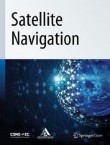Satellite Navigation welcomes submissions to the thematic series on ' GNSS Applications in Geosciences'.
Far beyond as a tool for positioning, navigation and timing in the military and civil worlds, the Global Navigation Satellite Systems (GNSS) have also become a significant Earth science discipline that extends our knowledge about the Earth dynamics and addresses hazards with substantial societal and economic impacts over the past decades. The continuous GNSS networks can provide millimeter-accuracy three-dimensional daily position time series for decades. The long-term highly accurate positioning time series provide direct observations about crustal motion and opportunities to understand geodynamics, which may be further used for the assessments of potential natural hazards (e.g., probability of an earthquake occurrence within a short timeframe). Meanwhile, recent technological advancements of GNSS receivers (even low-cost receivers) offer a higher sampling observation rate (up to 100 Hz). When empowered with advanced algorithms and right correction information, highly accurate real-time (or near real-time) positioning estimates could contribute to the establishment of an early warning system to mitigate the effects of natural hazards, such as earthquakes, landslides, volcanoes, hurricanes and tsunamis.
On the other hand, the GNSS signals transmitted from satellites to receivers are contaminated by the on-route disturbances, such as ionospheric and tropospheric delays, reflections from solid ground, water, grass, and ice. These signals have been mined for associated physical phenomenon, and new interdisciplinary including GNSS meteorology and GNSS-IR (interferometric reflectometry) has emerged.
In response to the burning social and economic sustainability demands, and to promoting widespread use and maximizing powerful impact of space geodesy on geosciences, this special issue invites papers that cover ongoing efforts to broaden the GNSS applications to all possible fields relevant to geosciences, especially in natural hazard monitoring. This may include but not limited to:
- GNSS monitoring receiver technology
- GNSS deformation time series analyzing and modelling
- GNSS geohazard monitoring and early warning
- Establishment and interpolation of GNSS networks for geodynamics
- GNSS atmosphere and weather forecast
- GNSS-R technology and applications
- GNSS integrity in Geosciences
- Other topics related to GNSS applications in Geosciences
- Exploitation of special features of BDS for Geohazard Monitoring
Prof. Yunbin Yuan
Innovation Academy for Precision Measurement Science and Technology, CAS, Hubei, China
Prof. Xiaolin Meng
Beijing University of Technology, Beijing, China
Prof. Guanwen Huang
Chang’an University, Shanxi, China
Prof. Cheng Yang
China University of Geosciences, Beijing, China
Submission Instructions
Before submitting your manuscript, please ensure you have carefully read the submission guidelines for Satellite Navigation. The complete manuscript should be submitted through the Satellite Navigation submission system. To ensure that you submit to the correct thematic series please select the appropriate thematic series in the "Additional Information" tab during submission. In addition, indicate within your cover letter that you wish your manuscript to be considered as part of the thematic series on ' GNSS Applications in Geosciences '. All submissions will undergo rigorous peer review and accepted articles will be published within the journal as a collection.
For editorial enquiries please contact
satellite-navigation@aircas.ac.cn/editorial_office@sana.org.cn.
Manuscript submission due date: 12/31/2023
Sign up for article alerts to keep updated on articles published in Satellite Navigation - including articles published in this thematic series!
